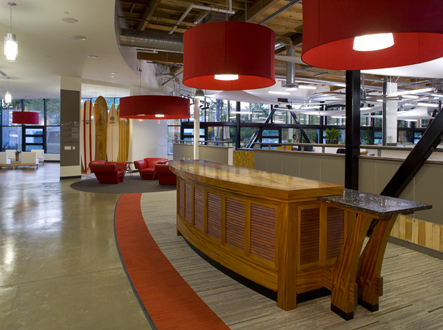DPR Construction Sustainable, Net-Zero San Diego Regional Headquarters

DPR Construction (DPR) announced today that construction is now complete on its new company-owned San Diego regional headquarters. The 24,000 square foot office located in University City is designed to be Net Zero Energy and is pursuing Platinum Certification through the U.S. Green Building Council’s Leadership in Energy Environmental Design (LEED) program.
“We set out to transform a typical San Diego suburban office building into a cutting edge facility that respects the environment, our people and our culture. All of us feel we’ve hit a home run. We’re committed to redefining the market place, both in terms of tenant expectations and developer interest in rehabilitating and renovating otherwise nearly obsolete buildings into highly desirable and attractive spaces,” said Jay Leopold, regional manager of DPR San Diego. “There are an abundance of buildings just like this that are potentially problematic for their owners, but we believe they represent opportunity. There are things you can do with these buildings in San Diego that you can’t do downtown or in mid-rises, and we believe we’re building a solid business case for doing so.”
The DPR office contains 11 conference rooms including the circular Delta room and a large training area, a 16 person video conference room and a space dedicated to building information modeling technology (BIM). In addition, the open office features over 14-foot exposed ceilings complete with scrims or material that hangs from the ceiling to defuse light, which are artistically designed to resemble the sails of boats.
“We recreated our cultural commitment to a work space that is wide open and transparent, with work stations in lieu of offices, continued Leopold. “With operable windows and skylights as well as glass garage doors to connect us to the outside, our cultural commitment to an open office environment is now supported by an office that is literally open to the environment.”
At the heart of the office sits the 14-foot wine bar, thoughtfully placed with the purpose of bringing staff members and outside guests together. The lobby area features four custom surfboards, each representing one of DPR’s four core values: integrity, enjoyment, uniqueness and ever forward.
To generate as much power as the building consumes, a 64 kilowatt AC photovoltaic system was installed. The solar panels are expected to produce enough power to offset the building’s energy consumption, annually.
According to Leopold, it was also important to the company to incorporate natural light and ventilation into building’s design.
“Our intent was to create an environment that was naturally ventilated and lit, and to do so in such a way that a person walking through the space wouldn’t even realize that there are no lights on or no air conditioning running,” he said. “In effect, we want to bring the outside in – not only because it’s the responsible thing to do but also because it’s a far superior working environment for our employees. The response to breathing fresh natural air was immediate and the positive response by everyone is really exciting.”
Bringing light into the building was achieved from several modifications to the structure including stripping the film off existing windows to allow more light into the office, installing 36 Solatubes or high-performance daylighting systems, as well as roof monitors or large operable skylights and glass roll up doors around the perimeter of the space. With these additions and new energy efficient lighting fixtures and controls, DPR estimates it will reduce the building’s energy consumption by 53 percent and that an outdoor view will be enjoyed in 90 percent of the office.
A state-of-the-art interconnected skylight building management system enables the windows to open to bring natural ventilation into the structure. When the outside and inside air temperatures reach a certain range, the system opens the windows and the skylight to naturally cross-ventilate and cool the open office area. As windows open, the HVAC system is shut down to conserve energy. This ventilation strategy is expected to reduce the number of operating hours of the HVAC system by 79 percent compared to a sealed building.
Other sustainable features include new preferred parking for fuel efficient vehicles, replacing the roof with an Energy Star product, diverting over 75 percent of construction waste from disposal in landfills, installing low flow plumbing fixtures to decrease water usage 51 percent, modifying the existing irrigation to reduce landscape water usage by 60 percent, and placing Dyson hand dryers in the bathrooms to decrease energy and waste from paper towels.
DPR also reused many materials from its previous office and the existing building such as 40 work stations and casework. More than 80 percent of the new wood was managed using the Forest Stewardship Council (FSC) principles and high recycled content materials were selected including tile, drywall and metal tiles. The carpet was also made from recycled materials and was adhered without glue with the volatile organic compounds (VOC) that are harmful to the Earth’s atmosphere. Other materials that used no or low-emitting VOCs included paints, coatings, composite woods, sealants, adhesives and caulking. In addition, used pallets were stripped and used throughout the space.
“At the end of the day, this building was designed to create an atmosphere that values our employees, our customers, our teammates, and the environment and with the goal of changing the world we live in by setting an example in our industry,” said Leopold.
The DPR Construction project team was comprised of Elizabeth Barrie, Jeff Cole, Jerry McElfresh and Mark Seidl. In addition, Jonathan Wood of Seattle-based Callison served as the architect of the project. Other consultants and designers included KEMA for LEED consultation; Hope Engineering for structural engineering; Latitude 33 Planning and Engineering for civil engineering; Howard Associates for landscape architecture; Bergelectric Corporation for electrical services; and Pacific Rim Mechanical for plumbing and mechanical services.
Posted on May 4, 2010
Last Updated August 23, 2022